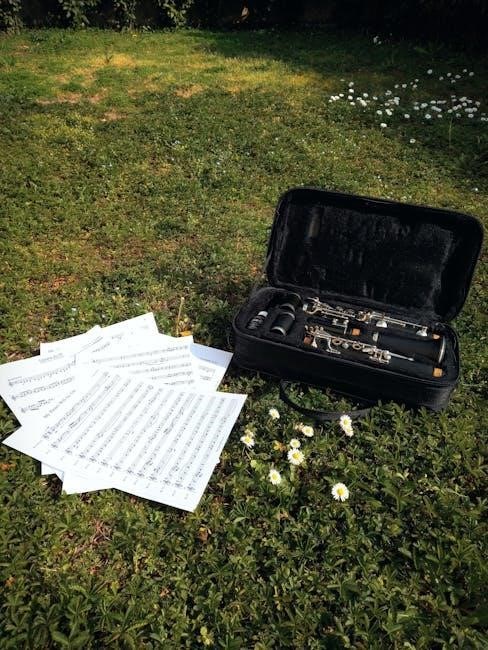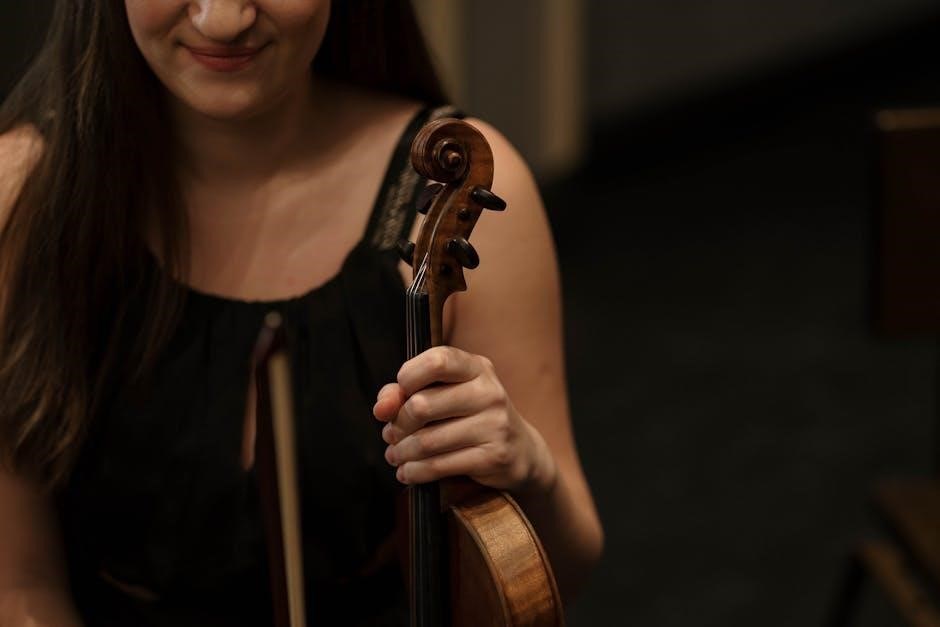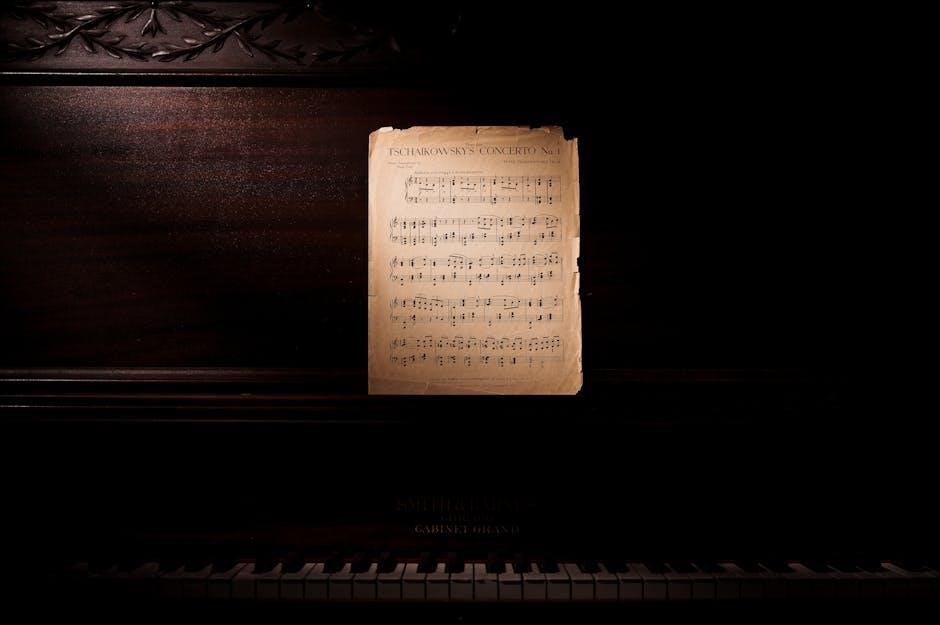Mozart Clarinet Concerto K. 622: Overview
Wolfgang Amadeus Mozart’s Clarinet Concerto in A major, K. 622, stands as a cornerstone of the clarinet repertoire. Composed in 1791, it showcases Mozart’s melodic genius and profound understanding of the clarinet’s capabilities.
Historical Context and Composition
Mozart composed the Clarinet Concerto K. 622 in 1791, during the final year of his life. This was a period of great creativity despite his declining health. The concerto was written for Anton Stadler, a close friend of Mozart and a virtuoso clarinetist, who played a clarinet with an extended lower range, sometimes referred to as a basset clarinet.
This instrument allowed Mozart to explore lower registers, adding depth and richness to the composition. The concerto is among Mozart’s last completed works. The concerto’s completion occurred only months before Mozart’s death in December 1791.
It represents the culmination of Mozart’s instrumental writing. Its creation coincided with other significant compositions, reflecting Mozart’s relentless dedication to music. The concerto’s genesis is intertwined with the late 18th-century Viennese musical scene. This scene was known for its patronage of the arts and embrace of innovation.
Significance as Mozart’s Final Instrumental Work
Mozart’s Clarinet Concerto holds a unique position in music history as his last purely instrumental work. Completed in 1791, shortly before his death, it represents a culmination of his genius. The concerto showcases Mozart’s profound understanding of instrumental capabilities. It also demonstrates his ability to craft melodies of unparalleled beauty. Its status as his final contribution to instrumental music elevates its significance.
This designation imbues the work with a sense of closure and reflection. It encapsulates Mozart’s lifetime of innovation. The concerto’s emotional depth and technical brilliance reflect the composer’s mastery. Its enduring popularity serves as a testament to its timeless appeal. This appeal resonates with audiences and performers alike, securing its place as a cherished masterpiece. Its influence on subsequent clarinet repertoire is undeniable. It stands as a benchmark for composers and performers.

Availability of Sheet Music in PDF Format
The Mozart Clarinet Concerto K. 622 is readily available in PDF format. This availability allows musicians easy access to scores for study and performance through various online platforms.
Free PDF Downloads: Sources and Considerations
Numerous websites offer free PDF downloads of the Mozart Clarinet Concerto K. 622 sheet music. These sources range from online music archives to individual musicians sharing their arrangements. While convenient, it’s crucial to consider the quality and accuracy of these free PDFs.
Some free versions may contain errors, be poorly scanned, or lack essential markings. Always compare multiple versions and cross-reference with reputable editions if possible. Public domain versions, often older editions, are a common source for free downloads, but may not reflect the most current scholarly understanding of the piece.
Be cautious of unauthorized distributions, as these can infringe on copyright. Reputable sites dedicated to providing legal access to free sheet music are preferable. Remember to support music publishers and composers by purchasing authorized editions when feasible.
Paid PDF Sheet Music: Publishers and Editions
For musicians seeking reliable and accurate sheet music of Mozart’s Clarinet Concerto, purchasing from reputable publishers is highly recommended. Several prominent publishers offer high-quality editions in PDF format, providing clear notation and scholarly insights.
Bärenreiter and Henle are renowned for their Urtext editions, which aim to present the music as close as possible to the composer’s original intentions. These editions often include detailed historical and editorial notes. Other publishers, such as Schirmer and Hal Leonard, also offer well-regarded editions, often with helpful performance suggestions.
When choosing a paid PDF, consider the editor, the included performance notes, and the overall clarity of the engraving. Purchasing a PDF grants you a legal copy for personal use and supports the ongoing work of music publishers in preserving and disseminating classical music.

Instrumental Versions and Transpositions
Mozart’s Clarinet Concerto exists in various instrumental versions and transpositions to accommodate different clarinets and performance contexts. These adaptations allow more musicians to access and perform this beloved work.
Clarinet in A vs. Clarinet in B-flat Versions
Mozart originally conceived his Clarinet Concerto in A major, K. 622, for the clarinet in A, an instrument commonly used in orchestras of his time. However, due to the popularity of the clarinet in B-flat, transpositions have emerged.
The primary difference between these versions lies in the key in which the music is written. The clarinet in A sounds a minor third lower than written, while the clarinet in B-flat sounds a major second lower. Therefore, to perform the concerto on a B-flat clarinet, the music must be transposed.
Many editions of the concerto offer both versions, allowing clarinetists to choose the instrument they prefer or the one that best suits the performance context. The transposed versions maintain the musical integrity of the original, while adapting it for the B-flat clarinet.
Piano Reduction for Rehearsal and Practice
The piano reduction of Mozart’s Clarinet Concerto, K. 622, serves as an invaluable tool for clarinetists during rehearsal and practice. This arrangement condenses the orchestral score into a single piano part, providing a harmonic and rhythmic framework for the soloist.
By practicing with the piano reduction, clarinetists can develop their musicality and intonation, whilst becoming familiar with the concerto’s structure and harmonic landscape. The piano part captures the essence of the orchestral accompaniment, allowing the soloist to refine their interpretation.
Furthermore, the piano reduction facilitates collaboration between clarinetists and pianists, enabling them to work together on the concerto’s intricacies. It is an accessible and practical resource for students and professionals alike, fostering a deeper understanding and appreciation.
Educational Resources and Performance Aids
Numerous educational resources and performance aids exist to assist musicians in learning and performing Mozart’s Clarinet Concerto. These tools enhance understanding, improve practice efficiency, and contribute to polished and expressive performances.
MP3 and MIDI Files for Practice
MP3 and MIDI files serve as invaluable practice aids for mastering Mozart’s Clarinet Concerto. These digital resources offer flexibility and convenience, allowing musicians to engage with the music in various ways. MP3 files provide audio recordings of the concerto, enabling students to listen to professional interpretations and familiarize themselves with the overall musical structure and phrasing. They can play along with these recordings, improving their timing and intonation.
MIDI files, on the other hand, offer a more interactive approach. These files contain digital representations of the notes, allowing users to adjust the tempo, isolate specific sections, and even transpose the music to different keys. This feature is particularly useful for clarinetists practicing difficult passages or working on specific technical challenges.
By utilizing both MP3 and MIDI files, students gain a comprehensive practice experience, combining passive listening with active engagement.
Study Scores and Analyses
Study scores and detailed analyses are indispensable tools for musicians seeking a deeper understanding of Mozart’s Clarinet Concerto. A study score provides the complete orchestral score in a reduced format, allowing clarinetists to examine the interplay between the solo part and the accompanying instruments. This enables a more informed and nuanced performance, as the soloist can appreciate the harmonic and thematic context of their own playing.
Analyses, whether in written or video form, offer insights into the concerto’s structure, harmony, and melodic development. These resources often explore Mozart’s compositional techniques, such as his use of counterpoint, ornamentation, and dynamics. By studying these analyses, clarinetists can gain a greater appreciation for the artistic intent behind the music and make more informed interpretive choices.
Combining a thorough examination of the study score with insightful analyses empowers musicians to deliver performances that are both technically proficient and deeply expressive.

Authentic Editions and Urtext Editions
For meticulous accuracy, authentic and Urtext editions are vital. These editions strive to present the music as Mozart intended, free from editorial additions or alterations, ensuring an accurate reflection of his original work.
Importance of Authentic Editions for Accuracy
Authentic editions of Mozart’s Clarinet Concerto K. 622 are paramount for musicians seeking to perform the work with the utmost accuracy and fidelity to the composer’s original intentions. These editions, often referred to as Urtext editions, meticulously present the score without editorial additions, alterations, or interpretations that may have accumulated over time.
The significance of authentic editions lies in their commitment to preserving the integrity of Mozart’s musical text. By relying on original manuscripts, early prints, and scholarly research, these editions offer a clear and unadulterated representation of the composer’s notation, phrasing, dynamics, and articulation. This ensures that performers can make informed musical decisions based on Mozart’s original intentions, rather than relying on potentially subjective or inaccurate interpretations. Using authentic editions enables a deeper understanding of Mozart’s musical language.
Notable Publishers: Bärenreiter, Henle
When seeking authentic editions of Mozart’s Clarinet Concerto K. 622, two publishers stand out for their commitment to scholarly accuracy and musical integrity: Bärenreiter and Henle. These publishers are renowned for producing Urtext editions, meticulously researched and edited to reflect the composer’s original intentions as closely as possible.
Bärenreiter editions are highly regarded for their detailed critical reports, which document the sources consulted and the editorial decisions made during the preparation of the score. This transparency allows performers to understand the rationale behind the edition and make informed choices about their interpretation. Henle Verlag is another esteemed publisher of Urtext editions, known for its elegant engraving and meticulous attention to detail. Henle editions undergo rigorous scholarly review. Both Bärenreiter and Henle provide invaluable resources for musicians.

The Legacy of Mozart’s Clarinet Concerto
Mozart’s Clarinet Concerto K. 622 is cherished for its beauty and impact on clarinet repertoire. Its influence continues through performances, recordings, and study, solidifying its place in musical history.
Its Popularity and Influence on Clarinet Repertoire
The Mozart Clarinet Concerto in A major, K. 622, enjoys immense popularity and holds a significant place in the clarinet repertoire. It is widely regarded as one of the most beautiful and important concertos ever written for the instrument. Its lasting appeal stems from its elegant melodies, exquisite orchestration, and the virtuosic opportunities it offers to clarinetists.
The concerto’s influence on subsequent clarinet compositions is undeniable. Composers have drawn inspiration from Mozart’s innovative use of the clarinet’s capabilities, particularly its lyrical and expressive qualities. The concerto has become a standard against which other clarinet concertos are measured, shaping the development of the instrument’s repertoire. Its enduring presence in concert halls, recordings, and educational settings testifies to its profound impact and lasting legacy in the world of classical music. The piece is performed by top clarinetists worldwide.
Availability of Parts and Full Scores
The Mozart Clarinet Concerto in A major, K. 622, is readily available in both individual parts and full scores, catering to the needs of performers, conductors, and music scholars. Numerous publishers offer printed editions of the parts, including the solo clarinet part, orchestral parts (such as flute, bassoon, horn, violins, alto, cello, and double bass), and piano reduction for rehearsal purposes.
Full scores, which present the complete orchestral arrangement alongside the solo clarinet part, are also widely accessible. These scores are essential for conductors leading performances of the concerto and for musicologists studying Mozart’s orchestration techniques. Both parts and full scores can be found through music retailers, online sheet music providers, and libraries. Digital versions, including PDF downloads, offer convenient access for study and performance. Availability ensures the concerto remains an important piece.